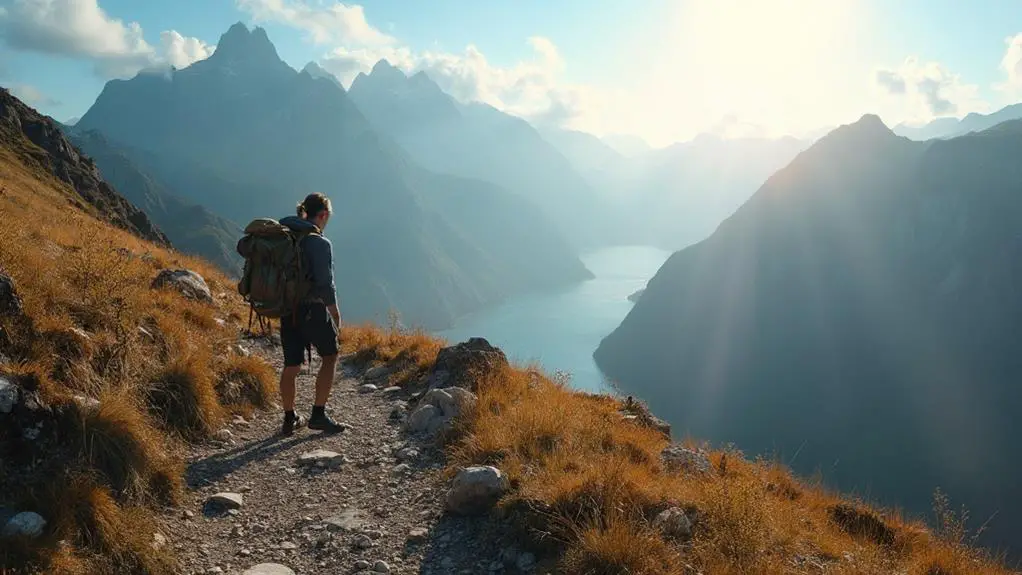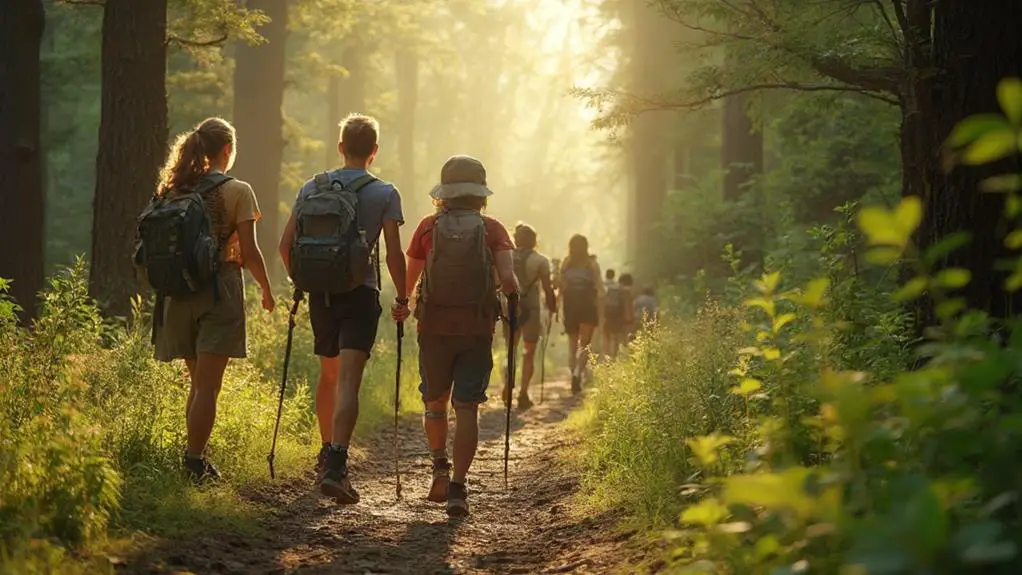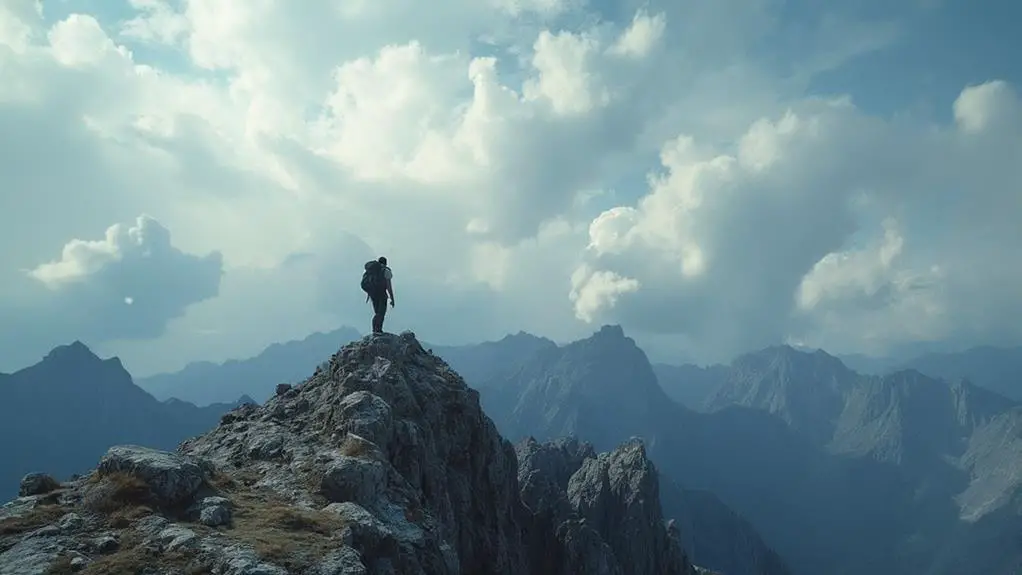Long-distance hiking poses significant mental challenges such as isolation, negative thoughts, and managing expectations. To overcome these, hikers should prepare mentally by using visualization, mindfulness, and research to anticipate trail conditions and emotional hurdles. Developing a positive mindset through cognitive reframing and positive self-talk enhances resilience, while setting achievable goals guarantees motivation. Engaging deeply with nature and utilizing support networks, whether through local hiking clubs or online communities, provides social support and companionship. Reflective practices like journaling help process experiences, reducing stress and fostering personal growth. These strategies can fortify the mind for the unique demands of long-distance hiking.
Key Takeaways
- Visualize difficult terrains to foster emotional preparedness and a positive mindset for long-distance hiking.
- Set realistic goals and acknowledge discomfort to align expectations with hiking realities and enhance motivation.
- Use mindfulness practices to stay present, reduce anxiety, and improve emotional regulation during hikes.
- Employ humor and positive self-talk to counter negative thoughts and maintain a constructive outlook.
- Engage with nature and document experiences to foster emotional connection and resilience during solitary hikes.
Mental Preparation Techniques
Beginning a long-distance hike demands not only physical endurance but also significant mental fortitude. To enhance mental readiness, hikers can employ mental imagery and emotional preparation techniques, which are integral to anticipating the challenges of the trail.
Visualization techniques, for instance, allow hikers to mentally simulate scenarios they might encounter, such as difficult terrains or variable weather conditions. By visualizing these potential obstacles, hikers can foster a positive mindset and prepare emotionally for their journey.
Additionally, thorough research into trail conditions, landmarks, and potential challenges aids in building mental resilience. Knowing what to expect reduces anxiety and fosters familiarity with the environment, thereby enhancing emotional preparation.
Developing a mental checklist for various scenarios, such as unexpected weather changes or physical discomfort, equips hikers with practical coping strategies, ensuring they are mentally prepared to navigate unforeseen challenges.
Mindfulness practices, such as focusing on the present moment and employing breathing techniques, further bolster mental clarity and reduce anxiety. These practices help maintain focus and calm, enabling hikers to remain centered and adaptable during long-distance hikes.
Together, these mental preparation techniques lay a robust foundation for the demanding journey ahead.
Managing Expectations

While mental preparation techniques equip hikers with essential tools for resilience, managing expectations is equally significant in steering the psychological demands of long-distance hiking.
Trail expectations often clash with hiking realities, making it vital to set realistic goals regarding distance and terrain. This approach helps prevent disappointment and fatigue, as long-distance hikes frequently contain challenging sections that may exceed initial assumptions.
Understanding that discomfort and exhaustion are inherent components of the hiking experience enables hikers to mentally prepare for these tough days, maintaining motivation throughout the journey.
Familiarizing oneself with the trail through detailed research, such as studying maps and reading hiker blogs, offers valuable insights into what to expect, thereby reducing anxiety and promoting a more positive mindset.
Accepting that not every moment on the trail will be picturesque or exciting fosters resilience, allowing hikers to appreciate the journey's entirety, including its ups and downs.
Mindfulness techniques can further assist in managing expectations:
- Staying present in the moment to enjoy immediate surroundings.
- Focusing on the journey rather than the destination.
- Acknowledging discomfort as temporary, which eases mental strain.
- Embracing unpredictability as part of the adventure.
These strategies collectively enhance the hiking experience by aligning expectations with realities.
Developing a Positive Mindset
Cultivating a positive mindset is a cornerstone of enduring the mental rigors of long-distance hiking. This journey requires mindset shifts that acknowledge discomfort and fatigue as integral to the experience. By setting realistic expectations, hikers can embrace these challenges as opportunities for growth, rather than deterrents.
Visualization techniques play a vital role in this process, enabling hikers to mentally rehearse both obstacles and triumphs. This proactive approach fosters emotional endurance, equipping them to face unforeseen challenges with resilience.
Incorporating positive self-talk and affirmations can greatly bolster mental fortitude. By countering negative thoughts during strenuous moments, hikers can maintain a constructive outlook. This practice is complemented by mindfulness, where focusing on the present moment and appreciating the surrounding nature can alleviate anxiety and enrich the overall experience.
Such practices enhance a hiker's capacity to endure mentally demanding situations. Setting small, achievable goals throughout the hike is another effective strategy. These milestones provide a sense of accomplishment and motivation, reinforcing a positive mindset.
Coping With Isolation

Isolation, a frequent companion on long-distance hikes, presents a unique mental challenge that requires deliberate strategies to manage effectively. Recognizing isolation as a common experience allows hikers to approach solitude management with empathy and preparedness.
Without regular social interaction, hikers can turn to auditory companionship through music or podcasts, which offer companionship alternatives and help maintain motivation. Engaging with nature can also provide solace; mindfulness practices or photography foster a nature connection, enhancing emotional resilience by grounding hikers in their surroundings.
Reflective journaling serves as a powerful tool for emotional processing, allowing individuals to articulate their feelings of loneliness and gain perspective. This practice helps maintain a positive mindset during extended periods of solitude. Humor strategies and positive self-talk further bolster emotional resilience, transforming moments of loneliness into opportunities for growth and introspection.
To effectively cope with isolation, consider the following strategies:
- Auditory Companionship: Use motivational playlists and podcasts to simulate social interaction.
- Nature Connection: Engage with surroundings through mindfulness or photography.
- Reflective Journaling: Document daily experiences to process emotions and maintain perspective.
- Humor Strategies: Employ humor and positive self-talk to enhance mental resilience.
Overcoming Negative Thoughts
Negative thoughts can be formidable adversaries for long-distance hikers, often exacerbating the physical and mental demands of the journey. Recognizing and addressing these negative thought patterns early is essential for maintaining mental resilience.
Research suggests that cognitive reframing—viewing challenges as opportunities for growth—can greatly bolster a hiker's mental fortitude. Engaging in positive self-talk is a practical strategy to reframe adversity, transforming intimidating obstacles into manageable experiences.
Journaling serves as an effective tool for reflection. By documenting their experiences, hikers can identify recurring negative thought patterns and gain perspective on their journey. This reflective process not only unearths underlying anxieties but also fosters a deeper understanding of one's emotional responses, paving the way for more constructive coping mechanisms.
Moreover, maintaining a sense of humor about challenging situations can lighten the mental burden. Laughing in the face of adversity can transform a potentially disheartening experience into a story of resilience and adaptability.
While the challenges of long-distance hiking are undeniable, adopting these strategies allows hikers to navigate their mental landscapes more effectively, promoting a fulfilling and enriching outdoor adventure. Through cognitive reframing and reflection, hikers can turn negative thoughts into catalysts for personal growth.
Harnessing Mindfulness Practices

Long-distance hiking presents unique mental challenges, which mindfulness practices can effectively address by helping hikers remain present and manage anxiety.
Techniques like focused breathing and body scans facilitate a deeper connection with the immediate environment, transforming potentially overwhelming experiences into moments of reflection and gratitude.
Evidence supports that by incorporating mindfulness into daily routines, hikers can enhance emotional regulation, leading to improved mental resilience on the trails.
Staying Present on Trails
Embracing mindfulness practices while hiking can greatly enhance the experience by keeping hikers mentally engaged and present. By fostering a nature connection through sensory grounding, hikers can enrich their journey and heighten awareness.
Techniques such as focused breathing and body scans anchor awareness to physical sensations and surroundings, offering a tangible method to stay present. Sensory observation, including noticing the vibrant colors of leaves or the wind's gentle whisper, deepens one's connection to nature and nurtures mindfulness.
Incorporating visualization techniques can further prepare hikers mentally for the trail's challenges. Imagining successfully maneuvering difficult sections instills confidence and a positive outlook, essential for maintaining mental resilience.
Regularly pausing to reflect on the hike's purpose and the natural beauty around can serve as crucial reminders to remain mindful, allowing gratitude and appreciation to flourish.
To effectively harness mindfulness, consider the following approaches:
- Engage in focused breathing to anchor present awareness.
- Practice sensory observation to foster deeper nature connections.
- Use visualization to mentally prepare for trail challenges.
- Pause for reflection to cultivate gratitude and mindfulness.
Mindfulness, practiced continuously, can transform discomfort into an accepted component of the adventure, enhancing the overall hiking experience.
Reducing Anxiety With Mindfulness
Mindfulness serves as a powerful tool for reducing anxiety during long-distance hiking, offering hikers a way to anchor themselves in the present and mitigate overwhelming thoughts. Techniques such as mindful breathing and body scanning are particularly effective at grounding individuals, encouraging them to focus on their immediate surroundings and sensations rather than potential challenges ahead. This shift in focus not only reduces anxiety but also enhances emotional regulation, allowing for greater awareness and management of both physical discomfort and mental fatigue.
Evidence suggests that engaging in mindfulness practices, such as visualization, can prepare hikers for potential obstacles. By mentally rehearsing scenarios and their solutions, hikers can approach real-world challenges with a sense of preparedness and calm.
Additionally, incorporating mindfulness into regular hiking routines—through practices like pausing to appreciate nature or expressing gratitude—serves to build mental resilience and counteract feelings of isolation.
Utilizing mindfulness apps or guided meditations during breaks offers a practical approach to maintaining a positive outlook. These tools provide structured support for stress management, further reinforcing a hiker's ability to stay present and focused.
Utilizing Support Networks

How does one navigate the solitude and emotional demands of long-distance hiking effectively? One potent strategy is the utilization of support networks. Engaging with online communities offers hikers a platform to share experiences, gather insights, and receive digital encouragement, thereby mitigating feelings of isolation.
These platforms foster social connections and emotional support, essential for maintaining mental resilience on long treks.
Joining local clubs or forming hiking partnerships can also provide tangible benefits. Such groups not only create opportunities for companionship and shared experiences but also enhance group motivation. The collective pursuit of common goals often results in increased morale and reduced loneliness.
Additionally, partnerships can offer practical assistance and emotional support during challenging phases of the hike.
Technology tools play an important role in maintaining these networks. Messaging apps and social media facilitate continuous contact with friends and family, providing hikers with an ongoing stream of emotional support and encouragement.
Consider these key strategies for building a robust support network:
- Participate in online hiking communities for shared experiences and tips.
- Join local hiking clubs to foster hiking partnerships and group motivation.
- Utilize technology tools for maintaining social connections and digital encouragement.
- Follow experienced hikers on social platforms for practical and mental strategies.
Enhancing the Hiking Experience

To truly enhance the hiking experience, one must integrate a blend of strategic practices that promote both mental and physical well-being. Nature photography serves as a powerful tool in this endeavor, encouraging hikers to pause and appreciate the intricate beauty of their surroundings, thereby fostering mindfulness and enriching the journey. This practice not only enhances enjoyment but also aids in managing stress by centering attention on the present moment.
In addition to photography, setting small, achievable goals along the trail can greatly bolster motivation. By breaking down the hike into manageable segments, individuals experience a heightened sense of accomplishment, which can transform a challenging journey into a series of rewarding milestones. This approach is particularly beneficial when faced with difficult terrain, as it shifts focus from the entirety of the task to immediate, attainable objectives.
Moreover, incorporating regular breaks is essential for both physical recovery and mental rejuvenation. These pauses provide opportunities for reflection and deepening one's connection with nature, further enhancing the hiking experience.
Engaging the senses through mindfulness practices reduces anxiety and fosters a profound appreciation for the environment. Additionally, listening to music or podcasts can serve as positive distractions, breaking negative thought patterns and uplifting the hiker's mood during strenuous sections.
Setting Achievable Goals

Establishing achievable goals is a cornerstone of successful long-distance hiking, offering both structure and motivation to navigate the arduous journey. By employing goal-setting strategies, hikers can break the trek into manageable daily sections, guaranteeing a consistent sense of accomplishment.
Setting mini-milestones such as reaching specific landmarks or completing a certain number of miles daily can act as motivation boosters, enhancing morale and providing a clear framework for tracking progress. Aligning these goals with personal motivations—whether aiming for physical fitness, mental clarity, or personal reflection—further strengthens commitment, ensuring hikers remain focused during challenging moments.
To maximize the effectiveness of goals, regular reassessment is essential. Adjusting goals based on daily conditions and personal energy levels helps maintain their realism and attainability, mitigating the risk of frustration or burnout.
Celebrating small victories, such as overcoming a difficult section of the trail or relishing a scenic view, reinforces a positive mindset and fuels ongoing motivation. These strategies provide not only a blueprint for success but also a psychological cushion during inevitable challenges.
- Break journeys into manageable sections for sustained motivation.
- Set mini-milestones to boost morale and track progress.
- Align goals with personal motivations for enhanced commitment.
- Regularly reassess goals to guarantee they remain realistic.
Embracing Nature's Beauty

Embracing nature's beauty through mindful observation techniques can profoundly enhance the mental experience of long-distance hiking by reducing stress and fostering a sense of presence.
By capturing scenic moments through photography or journaling, hikers can transform their journey into a series of meaningful interactions with the landscape, which research suggests enhances cognitive function and emotional processing.
Engaging all senses in the natural environment not only boosts creativity but also helps maintain motivation and combats mental fatigue, ensuring a more fulfilling hiking experience.
Mindful Observation Techniques
While traversing the vast expanses of nature, hikers often find themselves overwhelmed by the sheer beauty and complexity of their surroundings.
Mindful observation techniques, focusing on nature appreciation and sensory exploration, can transform this overwhelming experience into a source of tranquility and joy. By honing in on the finer details of the environment—such as the vibrant hues of autumn leaves or the intricate sounds of wildlife—a deeper connection to the natural world is cultivated.
This practice not only enhances appreciation for nature but also greatly reduces stress, promoting mental well-being during long-distance hikes.
Mindful observation involves a multi-faceted approach:
- Sensory Exploration: Engage all senses by feeling the textures of rocks, listening to rustling leaves, and inhaling the fresh mountain air.
- Mindfulness Breathing: Take deep breaths to tune into the environment's sensations, fostering a calming effect and grounding presence.
- Seasonal Awareness: Observe the dynamic changes and seasonal variations along the trail to maintain a sense of wonder and presence.
- Reflective Journaling: Document moments of awe to enhance emotional resilience and deepen the hiking experience.
Capturing Scenic Moments
Capturing scenic moments during long-distance hikes serves as a powerful tool for enhancing the hiking experience by directing attention to the natural beauty that surrounds adventurers. This practice, known as nature photography, transforms ordinary treks into extraordinary journeys by encouraging hikers to pause and truly observe their environment. It allows hikers to engage in scenic storytelling through images that tell the tale of their journey, fostering a more profound connection with nature.
Photography offers dual benefits—acting as a creative outlet and a form of mindfulness. By focusing on capturing the perfect shot, hikers can alleviate the mental fatigue and monotony often encountered on long trails, such as those found on the Scottish National Trail with its stunning hills and lochs. Documenting these landscapes fosters a sense of accomplishment and reflection, enhancing the overall hiking experience.
| Benefit | Description | Impact |
|---|---|---|
| Creative Outlet | Encourages artistic expression | Enhances engagement with surroundings |
| Mindfulness Practice | Promotes present-moment awareness | Reduces mental fatigue |
| Community Building | Sharing photos with others | Encourages exploration and appreciation |
Moreover, sharing captured moments through social media or with fellow hikers builds a sense of community, inspiring others to explore and cherish the natural world.
Engaging All Senses
Engaging all senses during a long-distance hike is a multidimensional approach to enhancing one's connection with the natural environment. By engaging in sensory exploration, hikers can form a deeper emotional connection to their surroundings.
Paying attention to the auditory cues, such as rustling leaves, birdsong, and flowing water, enriches the hiking experience by fostering a sense of presence and tranquility. Similarly, visual elements like the vibrant colors of wildflowers and the intricate textures of tree bark evoke feelings of joy and appreciation, enhancing emotional well-being.
The olfactory senses also play a significant role; the scent of pine trees or fresh earth post-rain can evoke memories, reinforcing the therapeutic benefits of nature. Taste, often overlooked, can be engaged by savoring foraged wild edibles or enjoying a meal in a scenic setting, adding another layer to the sensory experience.
- Sounds: Rustling leaves, birdsong, flowing water
- Sights: Vibrant wildflowers, varying tree bark textures
- Scents: Pine trees, fresh earth after rain
- Taste: Foraged wild edibles, meals at scenic spots
Mindfulness practices that emphasize sensory exploration can reduce stress, enhancing mental resilience on long-distance hikes. Through such practices, hikers cultivate a profound emotional connection with nature, promoting mental well-being.
Reflection and Growth

In the aftermath of a long-distance hike, the process of reflection plays a significant role in facilitating personal growth and self-awareness. Engaging in post-hike journaling serves as an essential tool for emotional processing, allowing individuals to document and analyze their experiences on the trail. This practice not only assists in articulating feelings of joy, frustration, and accomplishment but also provides valuable insights into the challenges encountered.
Through this self-examination, hikers can gain a deeper understanding of their emotional responses and mental resilience.
Sharing stories with fellow hikers further enriches this reflective process. It facilitates a communal exchange that reinforces lessons learned and underscores the emotional journey undertaken. This sense of community and belonging is key in fostering a supportive environment where personal growth is encouraged and shared.
Moreover, recognizing and embracing emotional fluctuations, such as joy and anxiety, offers a window into one's adaptability and mental fortitude. Mindfulness practices enhance this reflective experience, encouraging a positive mindset and appreciation for the journey.
This not only solidifies the immediate learnings from the hike but also inspires future outdoor adventures, highlighting the enduring benefits of reflection and personal development.
Building Mental Resilience

Building mental resilience for long-distance hiking begins with embracing discomfort and developing adaptability, recognizing these as essential components of the journey that can ultimately lead to personal growth.
Research suggests that visualization techniques—envisioning both successes and potential challenges—can prepare hikers mentally, enhancing their ability to tackle obstacles with confidence.
Additionally, cultivating positive self-talk has been shown to bolster motivation and perseverance, enabling hikers to maintain a constructive mindset even in the face of adversity.
Embrace Discomfort and Adaptability
While commencing on the arduous journey of long-distance hiking, hikers must recognize that embracing discomfort is not merely an aspect of the trek but a significant component in building mental resilience.
Discomfort acceptance plays a essential role in fostering this resilience, as hikers confront both physical and emotional challenges that are inherent to the trail. By adopting adaptability strategies, such as adjusting to unpredictable weather or maneuvering difficult terrain, hikers cultivate a flexible mindset, empowering them to seek solutions rather than yield to frustration.
Developing mental resilience involves integrating mindfulness practices into daily routines, such as deep breathing and visualization techniques. These practices help maintain focus and mitigate anxiety, keeping hikers grounded in the moment.
Additionally, positive self-talk and setting incremental goals can alleviate feelings of overwhelm, promoting a sense of achievement and reinforcing mental fortitude.
Understanding the coexistence of mental fatigue and physical exertion is essential. Regular breaks and moments of reflection aid in recovery and strengthen resilience against psychological challenges.
Key strategies include:
- Discomfort acceptance to normalize challenges.
- Adaptability strategies for flexible problem-solving.
- Mindfulness practices to enhance focus.
- Positive self-talk and goal-setting for motivation and mental strength.
Visualize Success and Challenges
Acknowledging the role of adaptability and resilience, hikers can further enhance their mental fortitude through visualization techniques that encompass both the triumphs and trials they might encounter on the trail.
Visualization techniques serve as a strategic approach to emotional preparedness, enabling hikers to mentally simulate the journey ahead. By envisaging both the successful completion of the hike and potential challenges, hikers can set realistic expectations for distance and terrain. This foresight fosters a positive mindset, as it allows them to mentally brace for obstacles while celebrating anticipated achievements.
Research indicates that familiarizing oneself with the trail—understanding conditions, landmarks, and expected adversities—can greatly reduce anxiety. This preparation builds confidence, allowing hikers to face the trail with a sense of readiness.
Developing a mental checklist for various scenarios further aids in maintaining focus, preventing negative thoughts from overshadowing the experience. Such preparedness not only enhances enjoyment but also fortifies mental resilience when inevitable discomfort arises.
Moreover, embracing the notion that challenges and discomfort are integral parts of the hiking experience encourages acceptance. This mindset shift, supported by visualization techniques, cultivates a resilient spirit, equipping hikers to navigate the emotional and physical demands of long-distance hiking.
Cultivate Positive Self-Talk
A pivotal strategy in strengthening mental resilience for long-distance hikers is cultivating positive self-talk. This approach is instrumental in counteracting negative thoughts, replacing them with affirmations of capability and strength.
Implementing affirmation techniques, such as motivational phrases, can remarkably enhance mental endurance, allowing hikers to manage physical challenges more effectively. Research supports that consistent positive self-dialogue reduces perceived exertion and increases enjoyment, transforming fatigue into a manageable aspect of the hiking experience.
Positive self-talk serves to reframe discomfort as an intrinsic part of the journey, promoting acceptance and thereby bolstering mental fortitude. Techniques like visualizing successful outcomes or repeating motivational phrases can greatly reinforce a positive mindset, essential for maintaining motivation through demanding trail sections.
This practice not only improves emotional well-being but also opens avenues for personal growth by turning challenges into opportunities.
To incorporate positive self-talk effectively:
- Use daily affirmations: Start each day with affirmations that emphasize strength and perseverance.
- Create a motivational phrase list: Develop a repertoire of phrases to use during tough moments.
- Visualize success: Regularly envision overcoming obstacles and reaching goals.
- Acknowledge progress: Celebrate small victories as they come.
Frequently Asked Questions
How Do You Build Mental Toughness for Hiking?
Building mental toughness for hiking involves employing visualization techniques to foresee challenges and practice positive affirmations to reinforce resilience. These strategies, grounded in evidence-based research, empower hikers to maintain motivation and psychological endurance during arduous journeys.
How Do You Mentally Prepare for a Long Hike?
To mentally prepare for a long hike, employ mindfulness techniques to maintain focus and reduce anxiety. Incorporate visualization exercises to envision overcoming challenges, enhancing confidence and creating a positive mindset, thereby ensuring a more enjoyable hiking experience.
How Do You Recover From a 20 Mile Hike?
Post-hike recovery from a 20-mile trek requires addressing muscle soreness through hydration, nutrition, and gentle stretching. Utilizing evidence-based practices, such as warm baths and adequate rest, can effectively enhance recovery, promote flexibility, and restore energy levels.
Which Is More Physically and Mentally Challenging Hiking or Trekking Why?
Trekking is more physically and mentally challenging due to its demanding routes, extended duration, and isolation, requiring advanced resilience. In contrast, hiking benefits from well-maintained paths and shorter durations, making it less strenuous than trekking differences suggest.
Conclusion
The mental challenges of long-distance hiking, though formidable, can be effectively navigated through strategic preparation and mindset cultivation. By employing techniques such as managing expectations, fostering a positive outlook, and setting achievable goals, hikers can enhance their mental resilience. Embracing the beauty of nature and engaging in reflective practices further contribute to personal growth. Evidence suggests that overcoming isolation and negative thoughts can transform these challenges into opportunities for profound self-discovery and psychological strengthening.